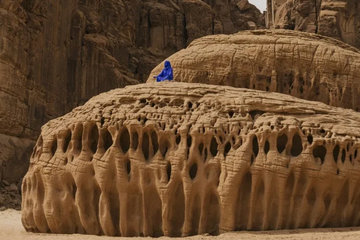
This week, it was revealed that Saudi Arabia has been selected by the member states of the World Heritage Committee of the United Nations Educational, Scientific and Cultural Organization (UNESCO) to be the organization’s vice chair, as a representative of the Arab group. This decision was announced during the Committee’s 44th session, which was hosted online and chaired from China. The Kingdom will act as vice chair from this year until 2023, when another member state will be elected to take on the role.
The World Heritage Committee, which comprises representatives of 21 countries elected by the UN General Assembly, also unanimously adopted a draft resolution submitted by Saudi Arabia that calls for building the capacities of heritage workers over the next decade. This resolution aims to boost diversity and expertise in the field, particularly of the youth, support regional organizations, and develop plans that aim to protect cultural sites.
The village of Thee Ain, Dhi Ayn or Zee Ain village is in the Al-Mikhwat province of the Al-Baha Region, Saudi Arabia.
— Saudi Buzz (@BuzzSaudi) August 8, 2021
This village is one of the heritage sites that the Council of Ministers approved to be registered in the World Heritage List of UNESCO.
Emmanuel Olvido pic.twitter.com/lde5keUfaT
UNESCO’s directives are aimed at encouraging the identification, protection, and preservation of cultural and natural heritage across the globe. In 1972, the organization adopted the Convention concerning Protection of the World Cultural and Natural Heritage. Amongst the many benefits of ratification for member states, the overarching one is that of “belonging to an international community of appreciation and concern for universally significant properties that embody a world of outstanding examples of cultural diversity and natural wealth,” as explained on UNESCO’s website.
Last month, the World Heritage Committee inscribed five cultural sites in Saudi Arabia, Austria, Belgium, Czechia, France, Germany, Italy, United Kingdom of Great Britain, and Northern Ireland on its World Heritage List. The Saudi Arabia site that was added to the list is Ḥimā Cultural Area, which is located in an arid, mountainous area southwest of the Kingdom.
UNESCO honored the Ḥimā Cultural Area in southwest Saudi Arabia for its rock carvings, which depicts plants and animals, as well as human activities, in its panoply of ancient art and writings. The site is located in a mountainous spot along an ancient caravan route. pic.twitter.com/bdlMdJx5dJ
— Saudia Radio (@saudia_radio) August 3, 2021
The site is described on the organization’s portal as “on one of the Arabian Peninsula’s ancient caravan routes” and “contains a substantial collection of rock art images depicting hunting, fauna, flora and lifestyles in a cultural continuity of 7,000 years.” The site has been frequented by many peoples over the course of its history, perhaps made most apparent by inscriptions on its walls in different scripts such as Musnad, Aramaic-Nabatean, South-Arabian, Thamudic, Greek, and Arabic.

















